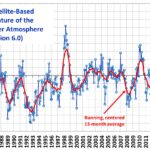Hoe meer kennis wetenschappers krijgen van de chaotische processen in de natuur, hoe nauwkeuriger ze er met voorspellingen naast kunnen zitten. Het enige dat vaststaat is verandering. Het jaar 2009 zou volgens de CRU-wetenschappers meer 0,4 graden boven het gemiddelde van 1961 tot 1990 liggen en een record-warmtejaar worden, zo meldde Reuters via een nieuwsbericht op 30 december 2008.
Het gemiddelde ligt daar met 0,260 ruim onder, volgens de data die Roy Spencer heeft gepubliceerd op basis van UAH MSU metingen. Ra ra hoe kan dat nu weer?
Spin?
Zelf laat ik de hardcore klimatologie graag over aan Marcel, ieder zijn ding. Wat me vooral interesseert is de klimaatspin via Reuters op dat moment, 30 december 2008. Was deze vorig jaar nodig om de neuzen eensgezind richting Global Warming te houden? Het bericht stelt: ‘Professor Phil Jones, director of the climate research unit at the University of East Anglia, said global warming had not gone away despite the fact that 2009, like the year just gone, would not break records. In oktober vorig jaar was in Londen net de vroegste sneeuw gevallen sinds 1930. Zulke gebeurtenissen hebben invloed op de publieke opinie, net als de recordsneeuw van nu.
we missen onze warmte
Natuurlijk zaten de climategate-wetenschappers van CRU vorig jaar ook met de afkoeling in hun maag, en het verlies van de hearts and minds voor global warming. Kijk maar in deze email van Phil Jones, de directeur van het CRU op 5 januari 2009
>—–Original Message—–
>From: Phil Jones [mailto:p.jones@xxxxxxxxx.xxx]
>Sent: 05 January 2009 16:18
>To: Johns, Tim; Folland, Chris
>Cc: Smith, Doug; Johns, Tim
>Subject: Re: FW: Temperatures in 2009> Tim, Chris,
>
I hope you’re not right about the lack of warming lasting
> till about 2020. I’d rather hoped to see the earlier Met Office
> press release with Doug’s paper that said something like –
> half the years to 2014 would exceed the warmest year currently on
> record, 1998!
> Still a way to go before 2014.
>
> I seem to be getting an email a week from skeptics saying
> where’s the warming gone. I know the warming is on the decadal
> scale, but it would be nice to wear their smug grins away.
Maar er zijn oplossingen. Een factor die letterlijk roet in het eten kan gooien van voorspellingen van Phil Jones en zijn CRU is bijvoorbeeld zwaveldioxide, SO2. Terwijl wij sinds de jaren zeventig onze SO2-uitstoot succesvol wisten te verminderen, lijken India en China de nieuwe bron te worden.
Chinese zwavel
En hier komt de sulfaathypothese om de hoek kijken in de onderlinge correspondentie in de CRU-emails. Deze hypothese is wel gebruikt om de mondiale afkoeling tussen de jaren veertig en zeventig van de vorige eeuw te verklaren. Een mogelijke extra afkoeling zou nu volgen omdat extra aerosolen uit China en India (roet en SO2) in de lucht de zonnestraling zouden temperen, tenminste, zo schrijft Michael mc Cracken aan Phil Jones en John Holdren, de adviseur van Obama. ‘Je moet je indekken, voor als je voorspelling niet uitkomt’, schrijft hij.
Zie hier de mail van Mike mc Cracken
—–Original Message—–
> From: Mike MacCracken [mailto:mmaccrac@xxxxxxxxx.xxx]
> Sent: 03 January 2009 16:44
> To: Phil Jones; Folland, Chris
> Cc: John Holdren; Rosina Bierbaum
> Subject: Temperatures in 2009
>
> Dear Phil and Chris–
>
> Your prediction for 2009 is very interesting (see note below for notice that went around to email list for a lot of US Congressional staff)–and I would expect the analysis you have done is correct. (Nee dus) But, I have one nagging question, and that is how much SO2/sulfate is being generated by the rising emissions from China and India (I know that at least some plants are using desulfurization–but that antidotes are not an inventory). I worry that what the western nations did in the mid 20th century is going to be what the eastern nations do in the next few decades–go to tall stacks so that, for the near-term, “dilution is the solution to pollution”.While I understand there are efforts to get much better inventories of CO2 emissions from these nations, when I asked a US EPA representative if their efforts were going to also inventory SO2 emissions (amount and height of emission), I was told they were not. So, it seems, the scientific uncertainty generated by not having good data from the mid-20th century is going to be repeated in the early 21st century
That there is a large potential for a cooling influence is sort of evident in the IPCC figure about the present sulfate distribution–most is right over China, for example, suggesting that the emissions are near the surface–something also that is, so to speak, ‘clear’ from the very poor visibility and air quality in China and India. So, the quick, fast, cheap fix is to put the SO2 out through tall stacks. The cooling potential also seems quite large as the plume would go out over the ocean with its low albedo–and right where a lot of water vapor is evaporated, so maybe one pulls down the water vapor feedback a little and this amplifies the sulfate cooling influence.
Zoals Marcel al schreef in Natuurwetenschap en Techniek in het artikel ‘de Klimaatklussers komen’is het toevoegen van sulfaat een onderzochte manier van Geo-engineering om temperaturen te drukken op aarde. Het idee komt deels af van vulkanen. Grote uitbarstingen als de Filipijnse Pinatubo in 1991 zorgen bijvoorbeeld een jaar of iets langer voor een sterke afkoeling.
> Now, I am not at all sure that having more tropospheric sulfate would be a bad idea as it would limit warming–I even have started suggesting that the least expensive and quickest geoengineering approach to limit global warming would be to enhance the sulfate loading–or at the very least we need to maintain the current sulfate cooling offset while we reduce CO2 emissions (and presumably therefore, SO2 emissions, unless we manage things) or we will get an extra bump of warming.
Sure, a bit more acid deposition, but it is not harmful over the ocean (so we only/mainly emit for trajectories heading out over the ocean) and the impacts of deposition may well be less that for global warming (will be a tough comparison, but likely worth looking at).
In any case, if the sulfate hypothesis is right, then your prediction of warming might end up being wrong.I think we have been too readily explaining the slow changes over past decade as a result of variability–that explanation is wearing thin.
I would just suggest, as a backup to your prediction, that you also do some checking on the sulfate issue, just so you might have a quantified explanation in case the prediction is wrong. Otherwise, the Skeptics will be all over us–the world is really cooling, the models are no good, etc. And all this just as the US is about ready to get serious on the issue.
>
> We all, and you all in particular, need to be prepared.
>
> Best, Mike MacCracken
Dus, heeft iemand van de lezers de China-sulfaathypothese al voorbij horen komen in media, om de kou uit de lucht te halen van de mislukte voorspelling en de recordsneeuw? Zo na de mediaspin van ‘het warmste decennium’is onderhand wel een nieuwe opwarmer nodig, om de hearts and minds voor global warming terug te winnen. Mijn voorspelling voor komend jaar is dat dit jaar anders zal verlopen als afgelopen jaar. Dan dek ik me alvast in.






En hoe verhoudt de dimmende werking van SO2 (als zwavelzuurdruppeltjes) zich tot het vermeende opwarmende effect van roetdeeltjes, zoals gesuggereerd in een recent onderzoek van het Goddart Institute? http://www.giss.nasa.gov/research/briefs/koch_05/
Het lijkt er eerder op dat hoe meer 'verklaringen' er komen voor opwarming of afkoeling hoe meer er juist onduidelijk wordt. Hetgeen uiteraard vooral een ondermijning is van de veronderstelde hoge waarschijnlijkheid van de IPCC-theorieën.
Waarschijnlijk vanwege bovenstaande onthulling in climategate dat het IPCC nu Latif naar voren schuift met zijn MDO cyclus. Lees: http://www.dailymail.co.uk/sciencetech/article-12…
Interessant artikel! Alleen niet te begrijpen hoe men deze cyclus alsnog in het kader van AGW plaatst. Zoiets schyzofreens als van:'De opwarming komt door AGW, maar de afkoeling door de oceaan oscillatie en die telt daarom niet.'
De zwavelemissies van Nederland liggen inmiddels op het niveau van 1880, zou dat misschien de oorzaak van de opwarming in Nederland in de recente jaren '80 zijn?
http://www.vkblog.nl/bericht/287371/De_koude_erfe…
Bron:
David I. Stern: Global sulfur emissions from 1850 to 2000, in: Chemosphere, Vol. 58, 2005, S. 163–175, doi:10.1016/j.chemosphere.2004.08.022 online data: http://www.sterndavidi.com/datasite.html
Nee dat zou toch niet, opwarming als gevolg van schonere lucht…
´t is maar net hoe je wil meten.
2009-2010 wordt ook weer de warmste winter sinds lange tijd. Kwestie van de 15 hoogste temperaturen nemen vanaf november t/m maart, en die vergeljken met andere jaren
http://www.timesonline.co.uk/tol/comment/columnis…
Simpel he?
De sulfaattheorie is inderdaad mogelijk een lapmiddel, die werd ingevoerd omdat de modellen niet veel kunnen met zo'n dip in het midden van de eeuw, er bestaat zacht gezegd nogal wat discussie over. Wat je uit de emails ook kunt opmaken is dat men vanalles doet om de modellen maar te redden
Een andere mogelijkheid van afkoeling houdt verband met oceaancycli, zoals Mojib Latif meldt, en dat betekent een andere verklaring die 'Het Grote Verhaal'moet conserveren. Een andere paper die ik zag voorbijkomen in GRL afgelopen september maakte een wiskundige analyse (wavelet geloof ik) van cycli, die de warmtesprongen en koudesprongen van afgelopen eeuw kon verklaren door het samenkomen van oscillaties als de PDO (die pas in 1996 is ontdekt, toen zaten er al weer twee IPCC-rapporten in de pocket)
Dan hebben we nog de inactieve zon, kortom met klimaat ben je nooit klaar, tenzij je milieuactivist bent: dan ben je er al uit voor je de wetenschap kent: het is de mens!
De behoefte bij alarmisten is te groot geweest om alles aan CO2 te hangen, een platonistische benadering van één centrale grondoorzaak die hoe dan ook zou moeten doorwerken onder de 'ruis'van andere 'bijzaken', bij Latif kun je die neiging ook nog steeds waarnemen, al is hij minder extreem dan Rahmstorf en de mensen van Realclimate
Ik blog daar nog wel even over, omdat instituten als het Planbureau voor de Leefomgeving zich ook aan deze narrative fallacy bezondigen (het Natuurlijk evenwicht) om nog maar te zwijgen van fondswervende bedrijven als Greenpeace en het Wereldnatuurfonds
Overigens was ik zelf als tiener ook een broeikasgelovige, ik nam aan dat wat men beweerde ook klopte. maar zodra je je meer gaat verdiepen in de materie zie je dat het verhaal veel te simpel wordt voorgesteld: je ziet ook dat wetenschappers maar van elkaar aannemen dat ze hun werk goed doen, terwijl dat natuurlijk niet zo hoeft te zijn
Voor mij was die constatering een ontnuchtering. Maar eigenlijk is het wel gezond, want wetenschapsverering staat vooruitgang in de weg
@curvedwater
Tot dusver een van de elf koudste winters van de laatste 40 jaar:
http://www.vkblog.nl/bericht/295991/Koud_he%3F